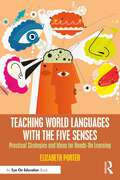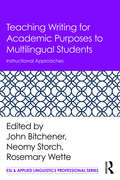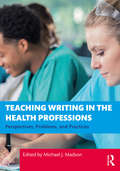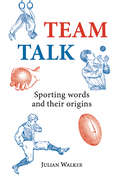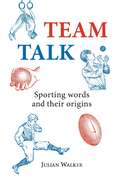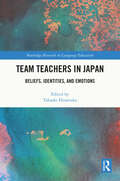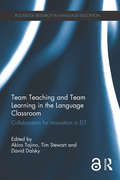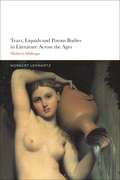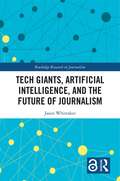- Table View
- List View
Teaching World Languages with the Five Senses: Practical Strategies and Ideas for Hands-On Learning
by Elizabeth PorterWith this fun, practical guide, you will have everything you need to re-envision and reinvigorate your world language classroom. Author Elizabeth Porter draws on a brain-based approach to show how language learning is a sensory experience. Students can effectively learn languages and improve retention through activities and lessons that incorporate the five senses – sight, hearing, taste, touch, and smell. Chapters include real-world, research-backed examples and classroom strategies and activities ready for use. An essential resource for world language teachers, this book introduces language learning philosophy and an out-of-the-box, effective approach that uses neuroscience combined with best practices to promote a highly engaging language learning environment.
Teaching World Languages with the Five Senses: Practical Strategies and Ideas for Hands-On Learning
by Elizabeth PorterWith this fun, practical guide, you will have everything you need to re-envision and reinvigorate your world language classroom. Author Elizabeth Porter draws on a brain-based approach to show how language learning is a sensory experience. Students can effectively learn languages and improve retention through activities and lessons that incorporate the five senses – sight, hearing, taste, touch, and smell. Chapters include real-world, research-backed examples and classroom strategies and activities ready for use. An essential resource for world language teachers, this book introduces language learning philosophy and an out-of-the-box, effective approach that uses neuroscience combined with best practices to promote a highly engaging language learning environment.
Teaching Writing: Effective approaches for the middle years
by Tessa DaffernIn the 21st century, writing is more important than at any other time in human history. Yet much of the emphasis in schooling has been on reading, and after the early years, writing skills have been given less attention. Internationally, too many children are leaving school without the writing skills they need to succeed in life. The evidence indicates that students rarely develop proficiency as writers without effective teacher instruction. Teaching Writing offers a comprehensive approach for the middle years of schooling, when the groundwork should be laid for the demanding writing tasks of senior school and the workplace. Teaching Writing outlines evidence-based principles of writing instruction for upper primary students and young adolescents. It presents strategies that are ready for adoption or adaptation, and exemplars to assist with designing and implementing writing lessons across the middle years of school. It addresses writing from a multimodal perspective while also highlighting the importance of teaching linguistic aspects of text design such as sentence structure, vocabulary and spelling as foundations for meaning-making. Contributors argue that students need to continue to develop their skills in both handwriting and keyboarding. Examples of the teaching of writing across disciplines are presented through a range of vignettes. Strategies for assessing student writing and for supporting students with diverse needs are also explored. With contributions from leading literacy educators, Teaching Writing is an invaluable resource for primary, secondary and pre-service teachers.
Teaching Writing: Effective approaches for the middle years
by Tessa Daffern Noella M. MackenzieIn the 21st century, writing is more important than at any other time in human history. Yet much of the emphasis in schooling has been on reading, and after the early years, writing skills have been given less attention. Internationally, too many children are leaving school without the writing skills they need to succeed in life. The evidence indicates that students rarely develop proficiency as writers without effective teacher instruction. Teaching Writing offers a comprehensive approach for the middle years of schooling, when the groundwork should be laid for the demanding writing tasks of senior school and the workplace. Teaching Writing outlines evidence-based principles of writing instruction for upper primary students and young adolescents. It presents strategies that are ready for adoption or adaptation, and exemplars to assist with designing and implementing writing lessons across the middle years of school. It addresses writing from a multimodal perspective while also highlighting the importance of teaching linguistic aspects of text design such as sentence structure, vocabulary and spelling as foundations for meaning-making. Contributors argue that students need to continue to develop their skills in both handwriting and keyboarding. Examples of the teaching of writing across disciplines are presented through a range of vignettes. Strategies for assessing student writing and for supporting students with diverse needs are also explored. With contributions from leading literacy educators, Teaching Writing is an invaluable resource for primary, secondary and pre-service teachers.
Teaching Writing for Academic Purposes to Multilingual Students: Instructional Approaches (ESL & Applied Linguistics Professional Series)
by John Bitchener Neomy Storch Rosemary WetteExamining what is involved in learning to write for academic purposes from a variety of perspectives, this book focuses in particular on issues related to academic writing instruction in diverse contexts, both geographical and disciplinary. Informed by current theory and research, leading experts in the field explain and illustrate instructional programs, tasks, and activities that help L2/multilingual writers develop knowledge of different genres, disciplinary expectations, and expertise in applying what they have learned in both educational and professional contexts.
Teaching Writing for Academic Purposes to Multilingual Students: Instructional Approaches (ESL & Applied Linguistics Professional Series)
by John Bitchener Neomy Storch Rosemary WetteExamining what is involved in learning to write for academic purposes from a variety of perspectives, this book focuses in particular on issues related to academic writing instruction in diverse contexts, both geographical and disciplinary. Informed by current theory and research, leading experts in the field explain and illustrate instructional programs, tasks, and activities that help L2/multilingual writers develop knowledge of different genres, disciplinary expectations, and expertise in applying what they have learned in both educational and professional contexts.
Teaching Writing in Chinese Speaking Areas (Studies in Writing #16)
by Mark Shiu-Kee Shum De-Lu ZhangOne of the most civilized nations in history, China has a long-standing writing tradition and many Chinese texts have become world treasures. However, the way the Chinese teach writing in various countries in contemporary times is little known to the outside world, especially in Western countries. Undoubtedly, the Chinese have had an established traditional method of writing instruction. However, recent social and political developments have created the perception amongst both practitioners and researchers of a need for change. Whilst certain socio-political changes, both in Mainland China and in the territories, acted as agents for reform of the teaching of composition, the shape these reforms are taking has been due to many different influences, coming both from inside the countries themselves and from foreign sources. Mainland China, Hong Kong, Taiwan and Singapore have each developed their own approach to the teaching of composition.
Teaching Writing in English as a Foreign Language: Teachers’ Cognition Formation and Reformation (English Language Education #28)
by Huan Zhao Lawrence Jun ZhangThis book explores teachers’ cognitions about the teaching of writing in English as a foreign language (EFL) and their teaching practice, as well as factors influencing the formation and reformation process of their cognition. Taking stock of Bakhtin’s dialogism as the theoretical framework, the authors argue that the formation and reformation of teacher cognition is a dialogic process. A systematic analysis of participating teachers’ cognition formation and re-formation process suggests the highly individual nature of teachers’ cognitions. EFL researchers and teachers, teacher educators, teacher education policymakers, university administrators and EFL textbook writers could draw on the findings of the study to provide better resources to implement the teaching of EFL writing more effectively. The study has adopted a mixed-methods approach, whose quantitative results show the patterns and differences of teacher cognition among teachers of different backgrounds and with different schooling, education and working experiences. The qualitative findings show in detail teachers' cognition formation and reformation processes and the factors contributing to such processes, revealing convergence and divergence of teachers’ stated cognitions, with a focus on the discrepancy between teacher cognition and teaching practice. These are useful lenses through which researchers and teachers will find significant implications for offering EFL writing instruction more effectively.
Teaching Writing in the Health Professions: Perspectives, Problems, and Practices
by Michael J. MadsonThis collection provides a research-based guide to instructional practices for writing in the health professions, promoting faculty development and bringing together perspectives from writing studies, technical communication, and health humanities. With employment in health-care sectors booming, writing instruction tailored for the health professions is in high demand. Writing instruction is critical in the health professions because health professionals, current and aspiring, need to communicate persuasively with patients, peers, mentors, and others. Writing instruction can also help cultivate professional identity, reflective practice, empathy, critical thinking, confidence, and organization, as well as research skills. This collection prepares faculty and administrators to meet this demand. It combines conceptual development of writing for the health professions as an emergent interdiscipline with evidence-based practices for instructors in academic, clinical, and community settings. Teaching Writing in the Health Professions is an essential resource for instructors, scholars, and program administrators in health disciplines, professional and technical communication, health humanities, and interdisciplinary writing studies. It informs the teaching of writing in programs in medicine, nursing, pharmacy and allied health, public health, and other related professions.
Teaching Writing in the Health Professions: Perspectives, Problems, and Practices
by Michael J. MadsonThis collection provides a research-based guide to instructional practices for writing in the health professions, promoting faculty development and bringing together perspectives from writing studies, technical communication, and health humanities. With employment in health-care sectors booming, writing instruction tailored for the health professions is in high demand. Writing instruction is critical in the health professions because health professionals, current and aspiring, need to communicate persuasively with patients, peers, mentors, and others. Writing instruction can also help cultivate professional identity, reflective practice, empathy, critical thinking, confidence, and organization, as well as research skills. This collection prepares faculty and administrators to meet this demand. It combines conceptual development of writing for the health professions as an emergent interdiscipline with evidence-based practices for instructors in academic, clinical, and community settings. Teaching Writing in the Health Professions is an essential resource for instructors, scholars, and program administrators in health disciplines, professional and technical communication, health humanities, and interdisciplinary writing studies. It informs the teaching of writing in programs in medicine, nursing, pharmacy and allied health, public health, and other related professions.
Teaching Writing through the Immigrant Story
by Heather Ostman Howard Tinberg Danizete MartínezTeaching Writing through the Immigrant Story explores the intersection between immigration and pedagogy via the narrative form. Embedded in the contexts of both student writing and student reading of literature chapters by scholars from four-year and two-year colleges and universities across the country, this book engages the topic of immigration within writing and literature courses as the site for extending, critiquing, and challenging assumptions about justice and equity while deepening students’ sense of ethics and humanity. Each of the chapters recognizes the prevalence of immigrant students in writing classrooms across the United States—including foreign-born, first- and second-generation Americans, and more—and the myriad opportunities and challenges those students present to their instructors. These contributors have seen the validity in the stories and experiences these students bring to the classroom—evidence of their lifetimes of complex learning in both academic and nonacademic settings. Like thousands of college-level instructors in the United States, they have immigrant stories of their own. The immigrant “narrative” offers a unique framework for knowledge production in which students and teachers may learn from each other, in which the ordinary power dynamic of teacher and students begins to shift, to enable empathy to emerge and to provide space for an authentic kind of pedagogy. By engaging writing and literature teachers within and outside the classroom, Teaching Writing through the Immigrant Story speaks to the immigrant narrative as a viable frame for teaching writing—an opportunity for building and articulating knowledge through academic discourse. The book creates a platform for immigration as a writing and literary theme, a framework for critical thinking, and a foundation for significant social change and advocacy. Contributors: Tuli Chatterji, Katie Daily, Libby Garland, Silvia Giagnoni, Sibylle Gruber, John Havard, Timothy Henderson, Brennan Herring, Lilian Mina, Rachel Pate, Emily Schnee, Elizabeth Stone
Teaching Young Learners in a Superdiverse World: Multimodal Approaches and Perspectives (Routledge Research in Education #190)
by Heather Lotherington Cheryl PaigeThis book documents a collaborative action research project in one school where researchers and practitioners worked together to develop multimodal literacies and pedagogies for diverse, multilingual elementary classrooms. Following chronologically from Lotherington’s Pedagogy of Multiliteracies (2011), this volume picks up after teachers and researchers have learned how to work efficiently as a learning community to offer project-based learning approaches. This edited collection relates how teachers and students of different grade levels, language backgrounds, and abilities developed a shared agenda and created a framework for effective and inclusive practices. Contributors demonstrate that collaboration, creative pedagogical solutions and innovative project-based learning are all essential parts of learning and teaching socially appropriate and responsive literacies in a multimodal, superdiverse world.
Teaching Young Learners in a Superdiverse World: Multimodal Approaches and Perspectives (Routledge Research in Education #190)
by Heather Lotherington Cheryl PaigeThis book documents a collaborative action research project in one school where researchers and practitioners worked together to develop multimodal literacies and pedagogies for diverse, multilingual elementary classrooms. Following chronologically from Lotherington’s Pedagogy of Multiliteracies (2011), this volume picks up after teachers and researchers have learned how to work efficiently as a learning community to offer project-based learning approaches. This edited collection relates how teachers and students of different grade levels, language backgrounds, and abilities developed a shared agenda and created a framework for effective and inclusive practices. Contributors demonstrate that collaboration, creative pedagogical solutions and innovative project-based learning are all essential parts of learning and teaching socially appropriate and responsive literacies in a multimodal, superdiverse world.
Teacup (tactile)
by Markeaton SchoolThis page shows an image of a teacup, a side view at the top and a top view at the bottom of the page. The cups handle sticks out to the right.
Team Talk: Sporting Words and their Origins (Shire General Ser. #2)
by Julian WalkerHave you ever wondered why we talk about a handicap in sport, why boxing is so named, or whether a dumbbell ever rang? It was during the nineteenth century that hitherto local games with relaxed and varying rules were formalized. During this process terminologies developed to refer to these new standardized sports, borrowing, modifying and redefining words from all walks of life in sometimes strange and unexpected ways. Considering such subjects as why sport shares so many words with the fields of hunting and conflict, and how English sports terms have been both adopted from and given to other languages, this book looks at how words have come into the field of sport and how they have developed and changed.
Team Talk: Sporting Words and their Origins
by Julian WalkerHave you ever wondered why we talk about a handicap in sport, why boxing is so named, or whether a dumbbell ever rang? It was during the nineteenth century that hitherto local games with relaxed and varying rules were formalized. During this process terminologies developed to refer to these new standardized sports, borrowing, modifying and redefining words from all walks of life in sometimes strange and unexpected ways. Considering such subjects as why sport shares so many words with the fields of hunting and conflict, and how English sports terms have been both adopted from and given to other languages, this book looks at how words have come into the field of sport and how they have developed and changed.
Team Teachers in Japan: Beliefs, Identities, and Emotions (Routledge Research in Language Education)
by Takaaki HiratsukaThis book provides insights into the professional and personal lives of local language teachers and foreign language teachers who conduct team-taught lessons together. It does this by using the Japanese context as an illustrative example. It re-explores in this context the professional experiences and personal positionings of Japanese teachers of English (JTEs) and foreign assistant language teachers (ALTs), as well as their team-teaching practices in Japan. This edited book is innovative in that 14 original empirical studies offer a comprehensive overview of the day-to-day professional experiences and realities of these team teachers in Japan, with its focus on their cognitive, ideological, and affective components. This is a multifaceted exploration into team teachers in their gestalt—who they are to themselves and in relation to their students, colleagues, community members, and crucially to their teaching partners. This book therefore offers several empirical and practical applications for future endeavors involving team teachers and those who engage with them—including their key stakeholders, such as researchers on them, their teacher educators, local boards of education, governments, and language learners from around the world.
Team Teachers in Japan: Beliefs, Identities, and Emotions (Routledge Research in Language Education)
This book provides insights into the professional and personal lives of local language teachers and foreign language teachers who conduct team-taught lessons together. It does this by using the Japanese context as an illustrative example. It re-explores in this context the professional experiences and personal positionings of Japanese teachers of English (JTEs) and foreign assistant language teachers (ALTs), as well as their team-teaching practices in Japan. This edited book is innovative in that 14 original empirical studies offer a comprehensive overview of the day-to-day professional experiences and realities of these team teachers in Japan, with its focus on their cognitive, ideological, and affective components. This is a multifaceted exploration into team teachers in their gestalt—who they are to themselves and in relation to their students, colleagues, community members, and crucially to their teaching partners. This book therefore offers several empirical and practical applications for future endeavors involving team teachers and those who engage with them—including their key stakeholders, such as researchers on them, their teacher educators, local boards of education, governments, and language learners from around the world.
Team Teaching and Team Learning in the Language Classroom: Collaboration for innovation in ELT (Routledge Research in Language Education)
by Akira Tajino Tim Stewart David DalskyThis book reignites discussion on the importance of collaboration and innovation in language education. The pivotal difference highlighted in this volume is the concept of team learning through collaborative relationships such as team teaching. It explores ways in which team learning happens in ELT environments and what emerges from these explorations is a more robust concept of team learning in language education. Coupled with this deeper understanding, the value of participant research is emphasised by defining the notion of ‘team’ to include all participants in the educational experience. Authors in this volume position practice ahead of theory as they struggle to make sense of the complex phenomena of language teaching and learning. The focus of this book is on the nexus between ELT theory and practice as viewed through the lens of collaboration. The volume aims to add to the current knowledge base in order to bridge the theory-practice gap regarding collaboration for innovation in language classrooms.
Team Teaching and Team Learning in the Language Classroom: Collaboration for innovation in ELT (Routledge Research in Language Education)
by Akira Tajino Tim Stewart David DalskyThis book reignites discussion on the importance of collaboration and innovation in language education. The pivotal difference highlighted in this volume is the concept of team learning through collaborative relationships such as team teaching. It explores ways in which team learning happens in ELT environments and what emerges from these explorations is a more robust concept of team learning in language education. Coupled with this deeper understanding, the value of participant research is emphasised by defining the notion of ‘team’ to include all participants in the educational experience. Authors in this volume position practice ahead of theory as they struggle to make sense of the complex phenomena of language teaching and learning. The focus of this book is on the nexus between ELT theory and practice as viewed through the lens of collaboration. The volume aims to add to the current knowledge base in order to bridge the theory-practice gap regarding collaboration for innovation in language classrooms.
Tears, Liquids and Porous Bodies in Literature Across the Ages: Niobe’s Siblings
by Norbert LennartzTaking in works from writers as diverse as William Shakespeare, William Wordsworth, Charlotte Brontë, John Keats, James Joyce and D.H. Lawrence, this book spans approximately 300 years and unpacks how bodily liquidity, porosity and petrification recur as a pattern and underlie the chequered history of the body and genders in literature.Lennartz examines the precarious relationship between porosity and its opposite – closure, containment and stoniness – and explores literary history as a meandering narrative in which 'female' porosity and 'manly' stoniness clash, showing how different societies and epochs respond to and engage with bodily porosity.This book considers the ways that this relationship is constantly renegotiated and where effusive and 'feminine' genres, such as 'sloppy' letters and streams of consciousness, are pitted against stony and astringent forms of masculinity, like epitaphs, sonnets and the Bildungsroman.
Tears, Liquids and Porous Bodies in Literature Across the Ages: Niobe’s Siblings
by Norbert LennartzTaking in works from writers as diverse as William Shakespeare, William Wordsworth, Charlotte Brontë, John Keats, James Joyce and D.H. Lawrence, this book spans approximately 300 years and unpacks how bodily liquidity, porosity and petrification recur as a pattern and underlie the chequered history of the body and genders in literature.Lennartz examines the precarious relationship between porosity and its opposite – closure, containment and stoniness – and explores literary history as a meandering narrative in which 'female' porosity and 'manly' stoniness clash, showing how different societies and epochs respond to and engage with bodily porosity.This book considers the ways that this relationship is constantly renegotiated and where effusive and 'feminine' genres, such as 'sloppy' letters and streams of consciousness, are pitted against stony and astringent forms of masculinity, like epitaphs, sonnets and the Bildungsroman.
Tech Giants, Artificial Intelligence, and the Future of Journalism (Routledge Research in Journalism)
by Jason Paul WhittakerThis book examines the impact of the "Big Five" technology companies – Apple, Alphabet/Google, Amazon, Facebook and Microsoft – on journalism and the media industries. It looks at the current role of algorithms and artificial intelligence in curating how we consume media and their increasing influence on the production of the news. Exploring the changes that the technology industry and automation have made in the past decade to the production, distribution and consumption of news globally, the book considers what happens to journalism once it is produced and enters the media ecosystems of the internet tech giants – and the impact of social media and AI on such things as fake news in the post-truth age. The audience for this book are students and researchers working in the field of digital media, and journalism studies or media studies more generally. It will also be useful to those who are looking for extended case studies of the role taken by tech giants such as Facebook and Google in the fake news scandal, or the role of Jeff Bezos in transforming The Washington Post. The Open Access version of this book, available at https://doi.org/10.4324/9781351013758, has been made available under a Creative Commons Attribution-Non Commercial-No Derivatives 4.0 license.
Tech Giants, Artificial Intelligence, and the Future of Journalism (Routledge Research in Journalism)
by Jason Paul WhittakerThis book examines the impact of the "Big Five" technology companies – Apple, Alphabet/Google, Amazon, Facebook and Microsoft – on journalism and the media industries. It looks at the current role of algorithms and artificial intelligence in curating how we consume media and their increasing influence on the production of the news. Exploring the changes that the technology industry and automation have made in the past decade to the production, distribution and consumption of news globally, the book considers what happens to journalism once it is produced and enters the media ecosystems of the internet tech giants – and the impact of social media and AI on such things as fake news in the post-truth age. The audience for this book are students and researchers working in the field of digital media, and journalism studies or media studies more generally. It will also be useful to those who are looking for extended case studies of the role taken by tech giants such as Facebook and Google in the fake news scandal, or the role of Jeff Bezos in transforming The Washington Post. The Open Access version of this book, available at https://doi.org/10.4324/9781351013758, has been made available under a Creative Commons Attribution-Non Commercial-No Derivatives 4.0 license.
Tech Terms: What Every Telecommunications and Digital Media Professional Should Know
by Jeff RutenbeckAn avalanche of acronyms, terms-of-art, buzz words, and short-hand phraseology confronts today's busy communications professionals. Now in its 3rd edition, Tech Terms is an invaluable learning tool to help grasp key aspects of the television and video, PC hardware and software markets, multimedia authoring tools, and the exploding wireless Internet and mobile telecomputing worlds. With more than 1000 terms described in four sentences or less, Tech Terms is perfect the perfect desk reference.
